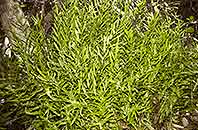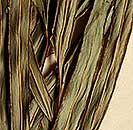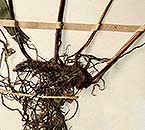Lindsaea ensifolia Sw.
Synonyms |
Schizoloma ensifolia (Sw.) J. Sm. |
|---|---|
Common name |
|
Description |
Rhizome creeping, c. 1-3 mm in diameter; rhizome scales pale to dark reddish brown, lanceolate in outline, with a long drawn out point, up to 2.5 mm long, margins entire. Fronds spaced 1-3 cm apart, erect, herbaceous, glabrous. Stipe brown, shiny, up to 36 cm long, glabrous except for a few scales near the base, grooved. Lamina up to 48 × 22 cm, imparipinnate, roughly oblonceolate in outline; fresh smelling lightly of almonds when crushed. Pinnae 7.5-22 × 0.4-2.5 cm, narrowly oblong-lanceolate in outline, shortly petiolate, base unequally cuneate, apex shortly tapering to slightly rounded, margin entire to shallowly lobed, veins forming 1-2 rows of areoles along each side of the costa, venation anastomosing. Rhachis sharply bi-angular. Sori linear, continuous along the fertile pinnae; indusium linear, semitransparent, opening outwards, 0.3-0.5 mm wide. |
Notes | Might superficially look a bit like Pteris cretica which has a shortly creeping rhizome with tufted fronds, pinnae with toothed margins, free veins and an indusium that opens inwards. Pteris cretica does not have a faint almond smell. |
Derivation | ensis: sword, folia: leaves; with swordlike leaves, referring to the long and tapering pinnae. |
Habitat | Low-altitude forest, usually in coastal swamp forest, on boggy ground or next to small streams in light shade. |
Distribution worldwide | Afrika, Madagascar, Mauritius, Pemba, Réunion, Seychelles and widely throughout southern Asia and the East Indies. |
Distribution in Africa |
Cameroon, Gabon, Ghana, Guinea, Mozambique, Nigeria, South Africa, Tanzania , Zimbabwe. |
Growth form |
Terrestrial. |
Literature |
|


